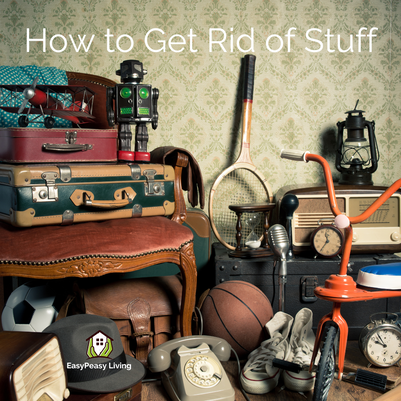 I love being a home organizer! Witnessing my clients’ sheer joy and relief at finally reclaiming their space always brings a smile to my face. Just the other day, I helped a client empty the storage unit she’d been renting for the past 18 months since moving from her home of 30+ years to a smaller condo…just in time to avoid paying next month’s rent!. (We celebrated with a chocolate milkshake…yum!) It’s amazing how much people actually love getting rid of stuff once they’ve made the decision to do it. So what makes deciding to do it so terribly difficult? Most often, not knowing what to do with excess belongings prevents folks from even starting to clear stuff out of their way. This procrastination leads to an ever-growing pile that eventually just feels too overwhelming for some. The longer they put it off, the more daunting the thought of shifting that enormous pile becomes. So it sits…and sits…and sits…gobbling up all of the available breathing space. That’s why I created a guide on how and where to donate, recycle or sell many of the most common items people struggle to divest. It has become the most-visited page on my website and elicits a surprising number of emails from readers wanting to contribute their own suggestions on what to do with all manner of cast-offs. If you haven’t yet visited this treasure trove of information, you’ll find it here in the Free Resources section. I encourage everyone to become part of this collaborative effort and email me if you know of ways to donate, sell, recycle or repurpose in ways not already mentioned. If you’ve been following my blog or Facebook page for any length of time, you’ve no doubt heard me mention the Buy Nothing Project. For those who are unaware of this enterprise, I strongly recommend visiting their website to learn more and consider joining your local group, especially if you yourself have excess stuff you need out of your way but don’t know how to go about getting rid of it. It's all about neighbors helping neighbors...and who doesn't love that?!! Many items that can’t be donated to charity can be shared with your neighbors who need them through a Buy Nothing group. Some examples include food items; opened-but-no-longer-wanted self-care items like shampoo/conditioner, nail polish, lotions or first aid supplies; leftover construction, DIY or craft materials; clothing or other household items with slight defects; cleaning solutions; broken electronics (yes, someone handy may want to fix them or use the parts); empty boxes, jars and packing materials. Heck, one woman in my group was even collecting leftover vegetable peels for making natural dyes! Many of my clients find it easier to part with their more sentimental objects when gifting them to someone that they know really needs or wants them than by merely adding them to a donation box without knowing exactly where they will end up. All it really involves is posting a photo and brief description on the group’s Facebook page to be connected to members who are interested in what you have to offer. If you want to give Buy Nothing a try but aren't sure where to start, request a copy of my free guide to joining and using Buy Nothing. Once you join your local group and understand how it works, getting rid of unwanted items as you go becomes easy peasy and prevents unwanted pileup in your cabinets and closets. It's truly a win for everyone, including the environment! Nothing feels better than coming together as a community to meet each other’s needs. My need for more space and your need for the items I no longer want that are hogging all of it are a match made in heaven! With a little information on what to do with all that stuff, even reclaiming your space can be easy peasy!
0 Comments
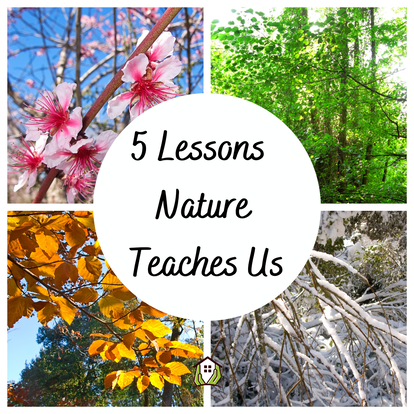 Have you ever noticed that we human beings seem to spend a significant portion of our lives dealing with stress, anxiety and pressure? I don’t get the sense that the rest of nature experiences that. Sure, I guess if you’re a gazelle being chased by a lion, you’re gonna feel a bit anxious, but I somehow doubt that gazelles spend the same percentage of their time under such constant duress that we humans do. Perhaps nature can teach us a few things. Ever since last week’s walk around the neighborhood without music, I’ve been taking lots of musicless walks. In fact, I’ve been taking only musicless walks, which has allowed me to notice a number of patterns about the natural world that I've never really focused on before because I was so wrapped up in my own thoughts all the time...truths that, if we just accepted and adopted them in our own lives, would help us lead a calmer, less stressful existence.
I think the old saying that you should “take time to stop and smell the roses” is about much more than just appreciating their beautiful scent. It’s about leaning in close enough to hear all that the roses are telling you. Don't miss out! Sign up to have each new EPL Blog post delivered to your inbox each week.
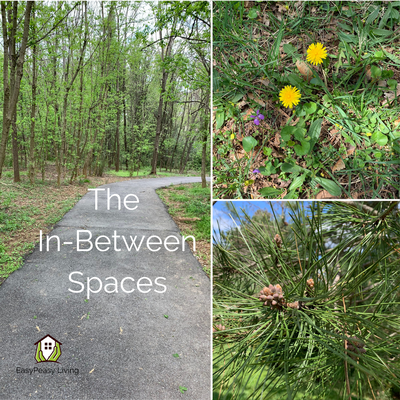 If you follow me on Facebook you’re probably aware that our theme for April is Earth Month. My original plan was to offer some gardening-related tips and advice in today’s blog post, but to anyone who knows me well, that notion is spit-out-your-coffee laughable. To say that I do not have a green thumb is the understatement of the year. My best gardening advice is to never trust me with your plants. Having said that, just because I seem incapable of growing things myself doesn’t mean I don’t have a deep appreciation for the things other people grow. In fact, I probably appreciate them even more because of my gardening “disability”. I enjoy having fresh cut flowers in my home while they last and like to admire other people’s gardens. Anyone who finds themselves with an over-abundance of fresh herbs or vegetables to share from their garden will find a grateful and enthusiastic taker here. I do have some azalea bushes and a rhododendron in my front yard and hydrangeas in my backyard that make me smile, partly because they remind me of my mother and partly because they seem to find a way to bloom beautifully year after year despite the fact that they live in my yard. In any case, faced with a dearth of ideas on what to write about in this week’s blog on the topic of gardening and having some unexpected space in my daily routine yesterday, I decided to take a walk in the hopes that some sort of inspiration would jump into my path while I was admiring the fruits of other people’s labors in my neighborhood. And I did something I almost never do when going out for a walk on my own: I left my music at home and allowed the sounds around me to accompany my walk instead. It was an eye- (and ear-) opening experience. I never realized before how much listening to music on my walks distracted me from connecting with the world around me. It sounds silly, now that I think of it, that I never noticed until now how much my music drowned out my environment and forced my focus inward. In fact, the purpose of my walks in the past has typically been more about de-stressing and processing what’s in my head and heart, whereas yesterday’s intention was to connect with my surroundings and let them lead my thoughts. It was pretty powerful. I frankly expected this walk to be a little bit boring with all that open space in my mind, but I soon discovered how wrong I was. As I walked along the sidewalk leading up to my kids’ elementary school, I was greeted with a flood of memories...reminders of the many times I had walked my two now-teens to school as young children, of the conversations we’d had, of their joyfulness at meeting some of their friends along the way, of the worries I had often mulled over on my way home after dropping them off. Then I was drawn further back to my own childhood memories of climbing the small overgrown hill across from our bus stop to taste the honeysuckle before racing back down to the corner when the designated lookout shouted “BUS!” As I passed neighbors dutifully pruning and watering their carefully-tended gardens, I recalled my mother weeding the three round flower beds in our backyard and how my sisters and I still chuckle about the time we spotted our next door neighbor tending her garden in a white dress and high heels on her way in from church, such was her commitment to it. As I turned the corner, I noticed the dandelions that had already turned white and remembered how we’d blow on them as kids, even though our parents told us not to...something kids still do today, and just as they no-doubt have done for centuries. There’s a comfort in knowing that we are connected down through the ages by a shared fascination with creation. When I was young, my father would take us backpacking. We’d go days at a time without seeing another living soul. I didn’t like that feeling of isolation, of separateness, of space between us and the rest of the world. But then I would imagine that we were treading upon the same land, surrounded by the same woods that native peoples and pioneers had trod upon two hundred years before us, and it reminded me that we were part of something eternal, something difficult to explain yet comforting that filled the gap between me and the rest of humanity in those lonely moments/ I took some time to appreciate the textures of the trees, which brought a smile to my lips. My father was also an avid amateur photographer when I was growing up and there were (and I assume still are) lots and lots (and lots) of photos of tree bark taken using a variety of shutter speeds and apertures among his vast slide collection. Remembering how I once stood for what seemed like hours in the snow, holding an umbrella over him and his camera equipment so that he could capture the May snow atop the fully blooming forsythia hedge in our backyard brought back warm thoughts as I continued on my breezy walk yesterday. All these memories carried with them a tidal wave of mixed emotions that quickly filled every space within my brain. I felt love for my family and joy at recalling scenes from both childhood and young motherhood; regret over having missed out on potentially thousands of similar walks I didn’t take over the years because I was too busy, too lazy or too wrapped up in my own thoughts to pay attention; agonizing grief over the loss of loved ones now gone, opportunities missed with my children, time wasted worrying about trivial things; gratitude at the gift of this beautiful creation through which we are all connected; humility at realizing that I am but a tiny speck in this grand, great universe, yet awe that I was created with the same loving attention to detail as the itty bitty budding pinecones I had just inspected. As I sat down to process all of these feelings, I noticed a hawk gliding through the air above the trees that circled the chain link fence surrounding a tennis court. The lack of music on this walk made space for me to discern the dichotomy of sounds I was hearing...birds chirping in the trees as well as a distant lawn mower. I turned over in my head these examples of nature contrasted with the signs of modern development and technology, coexisting in the beautiful setting of our neighborhood park. I stood up and continued down the paved path that led through the woods. The asphalt made this shortcut through a lovely secluded spot more navigable for walkers and bike-riders alike, yet there was little traffic. Again, man-made convenience and natural beauty occupying the same space. I was struck by how all these contrasting elements made my walk feel richer and more interesting somehow. I don’t know if it’s just the organizer in me, or if it’s simply part of human nature to want to label everything we experience and put it neatly into its designated spot, leaving no spaces empty lest something uncategorized creep in there. I thought about where I’d file this walk. Does it fit most neatly under love, joy, regret, sorrow, guilt, gratitude, or humility? The answer is it was all of the above. It certainly wasn't what I expected it to be. It simultaneously made me both happy and sad. I mostly loved it but also didn't. Perhaps I can just let it be something undefinable, I thought. Why does everything have to be simplified and labeled? After all, life is complex...we are complex. Sometimes complexity is messy, but therein lies its beauty. How often do we lose out to our need to neaten it up? We ignore one thought, idea or emotion in favor of another because we feel like we can’t process both, instead of just living in that uncomfortable-yet-fascinating space in-between them? We label people, institutions, ideas and experiences as friend or foe, ally or adversary, acceptable or unacceptable, positive or negative, when the reality is that most of what we encounter in life is a mixture of both and of everything in-between. My simple nature walk reminded me that just as the beauty of the rainbow lies in the wide range of its colors, the beauty of life is experienced through our ability to detect and savor all the subtle nuances contained within our relationships, emotions and experiences and to value each and every varying shade. I can love someone who has made me angry, be disappointed at the choices my children make and still be proud of who they are, disagree profoundly with my friend and still grow from all she continues to teach me, or recognize some positive quality in a person I find generally loathesome. I can wish for time alone yet be comforted by those constantly surrounding me. I can feel gratitude for all my blessings while working to bring about change, just as I can desire challenge while craving rest. Life is most fully lived and meaningful when we allow ourselves to exist in and experience those spaces in-between our labels. When I was a child, I didn’t get why grownups wouldn’t want dandelions growing in their lawns: “Because they’re weeds”, was the answer I was given. “So?” I’d say, “They make the yard look pretty.” “But they’re weeds,” my parents insisted. Now I understand. We were both right. Even weeds can be pretty and even pretty things can be unwanted. Dandelions grow in the in-between spaces. Don't miss out! Sign up to have each new EPL Blog post delivered to your inbox each week.
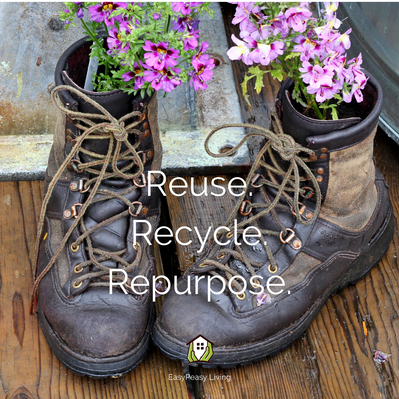 Whether you believe climate change is manmade or not, one truth is irrefutable: it is in our own best interest as a species to be good stewards of the earth and its resources. Having grown up in the 70s and 80s, I can remember a time when our family of six generated so much garbage that two large trash cans were not enough to accommodate it all in between our twice-weekly collection days. (I know this because I was one of the ones who was charged with carrying it all down to the end of our long driveway on trash days...and which a failure to do often resulted in me losing television privileges for a week or more!) When recycling was first introduced, it seemed onerous. Even just remembering not to throw cans and glass jars in the trash can was a hurdle we all had to overcome. Today it has become second nature, and I’m pleased to report that our family of four almost never fills up our one large garbage bin often enough to warrant putting it out for the second trash collection each week. (Much to my teenage son’s chagrin, though, there’s still plenty of recycling to put out...in which a failure to do often results in him losing his gaming privileges. I guess the more things change, the more they stay the same.) The point is that according to the EPA, landfilling of municipal solid waste (MSW) in the United States has decreased from 94% in 1960 to 50% in 2018 and composting and recycling rates have increased from 6% in 1960 to 32.1% in 2018...all due to society collectively adopting one new habit to make a difference over time. Just think what a big difference we could make over the next 58 years by becoming just a bit more intentional about how we consume. Sometimes purchasing something new is necessary, and doing so helps to create jobs and has a positive impact on our economy. But embracing a philosophy of “less is more” can not only save you money and space (both highly-sought-after commodities in most American homes) but can also make you a more responsible consumer and steward of our natural resources. Next time you find yourself reaching for your phone or logging onto your computer to order something online, or drawn to an item on a store shelf, ask yourself these six questions first:
Every time you buy something new, you generate waste. When you order online, your purchase will arrive in boxes or bubble mailers, often with additional packaging materials enclosed, delivered in planes and trucks that consume fuel and pollute the air. Even if you purchase something from a brick and mortar store, you are consuming gasoline to get there and your item/s still arrived at the store in boxes with packaging on gas-powered, pollution-generating vehicles. You may even get a receipt generated on thermal paper (which cannot be recycled) and carry your items home in a plastic or paper bag. This is before we even get to what happens to the item you bought or the container it came in once you are done using it. Needless to say, cutting back even just a little bit on new purchases and learning how to responsibly minimize, dispose of, or reuse the waste they generate will make a huge difference over the remaining decades of your life. If each person makes even a small change in how they consume, this could add up to a major shift in our society’s impact upon our environment. And don't forget, there's the added bonus of having less stuff to manage in your home. Everything you buy has an overhead cost attached to it. I know, I know, this can sound a bit overwhelming and like a lot of work to someone who is used to simply ordering whatever you need, whenever you need it as long as there's the money to do it. Just as with any change, it requires adopting new habits, and that can feel intimidating at the start...just like recycling was for many of us back in the early days. It helps to develop three crucial tools you already have at your fingertips: your network, your imagination, and your knowledge. Some of these may be stronger than others, but with minimal effort and a bit of forethought, you can become an expert at wielding all three to help you achieve your goal of buying less. Your Network Friends, family, co-workers, members of your faith community, neighbors (both those you already know in person and those you can connect with online) and professional service providers all constitute a vast network of available resources, but how often do you really utilize them in acquiring the goods you consume? Here are a few ways to tap into your network instead of filling up your Amazon shopping cart.
Your Imagination Using your creativity to identify possible alternative solutions to buying something new is a skill you can develop. Pinterest is my go-to place to start when I need to jumpstart my creative juices on just about anything. The more you peruse DIY magazines and sites, the easier it will be for you to recall ideas you’ve seen before. Again, ask your network to step in if you are stumped before you pull out your wallet and buy something new. Think of it as a challenge...a sort of game to make something out of nothing. Did you follow my 25 Days of Christmas Ornaments posts on Facebook back in December? All of the ornaments I made used materials from around my house. That was my rule for myself. Here are just a few ways to use your imagination to avoid making new purchases that will become second nature once you're in the habit of using them:
Your Knowledge Obviously knowing how to make what you need yourself out of items you already have is one way your knowledge can help minimize your purchasing of new goods, as does knowing how to grow your own vegetables and bake your own bread. But knowing how/where to recycle, what is safe to reuse or re-purpose, and when to replace something is equally important. Fortunately, most of these answers can be found on the internet just as easily as finding a new product to buy. Your knowledge will accumulate over time with enough curiosity. Here are some ways more knowledge can result in fewer swipes of your credit card:
With a smidgeon of knowledge and creativity, along with a little help from your friends, even becoming a more intentional consumer can be easy peasy. Don't miss out! Sign up to have each new EPL Blog post delivered to your inbox each week.
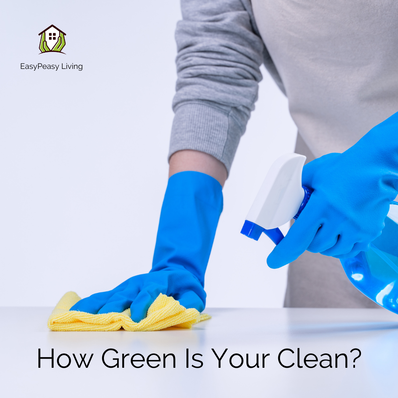 “We do not inherit the earth from our ancestors...we borrow it from our children.” -Native American Proverb April 22 is Earth Day...the day we honor and celebrate our beautiful planet! I love Earth Day because this living, breathing, incredible home is the one thing all of us--regardless of race, culture, religion, political ideology, sexual orientation, nationality, or even species--share. This enduring world sustains us, and during the month of April, there are always endless opportunities to return the favor by nurturing nature, conserving and replenishing our natural resources, and cleaning up after ourselves. And speaking of cleaning up after ourselves, one of the easiest ways we can show Planet Earth some love all year long is to reduce our dependence on harsh chemicals when cleaning our homes. In the early days of the Coronavirus pandemic, there was a heavy emphasis on sanitizing and disinfecting every surface, as fomite transmission was thought to be one way the virus was spread. Scientists have since learned that transmission of the virus through contaminated surfaces is relatively rare. Still, many of us are continuing to overuse chemicals because it makes us feel better. A more effective way to protect ourselves is by improving ventilation, wearing a mask when out in public, social distancing and frequent hand-washing. Definitely once you are vaccinated against SARS-CoV2, you might want to cut back a bit on the harsh disinfectants that can also harm your health and the environment. “Green cleaning” our homes is also more convenient and easier on your wallet. With just a few versatile ingredients--most of which you probably already have on hand--you can mix up your own non-toxic cleaning solutions anytime you need them. Compare the cost of a single batch of the commonly-used, chemical-laden cleaners below to the simple, everyday ingredients needed to make multiple batches of the environmentally-friendly versions: Store-bought Solutions: Tilex - $3.99 Windex - $3.19 Comet - $.99 Fantastik - $4.99 Murphy's Oil Soap - $3.49 Windex Electronics Wipes - $2.99 Tide Liquid Laundry Detergent - $8.79 Shout Stain Remover - $2.97 Clorox Automatic Toilet Bowl Tablets - $4.99 Clorox Wipes - $4.99 Total Cost - $54.54 Homemade Ingredients: White Vinegar - $1.99 Water - FREE Rubbing Alcohol - $.99 Borax $4.49 Dawn Dish washing Liquid - $2.50 Ammonia $.99 Salt - $.89 Citric Acid - $2.97 Castile Soap with Tea Tree Oil - $6.69 Washing Soda - $3.97 Lemon Essential Oil - $6.99 Total cost - $32.97 Savings - $21.57 (That’s a 40% savings on just the first batch, plus you’ll have enough ingredients leftover to make additional batches for free!) Cutting back on the chemicals in the cleaning solutions you use is just one way green cleaning helps the environment and saves you money. Consider the benefits of recycling as you clean. For example, instead of buying a new spray bottle of commercial glass cleaner or a jug of laundry detergent every month, refill your own spray bottle and jug with the homemade versions to reduce the amount of plastic your family consumes. Keep all those disposable disinfecting wipes out of the landfill by replacing them with reusable cleaning cloths. Recycle old newspapers for cleaning your windows. Heck, you can even put that old mateless sock to good use over and over again on your Swiffer in place of buying the disposable sweeper cloths. When your t shirts, towels, cloth napkins, and dish towels become worn and ratty, downgrade them to cleaning rags. I save the worst-looking ones that are truly nearing the end of their usefulness for washing the car or in place of paper towels for cleaning up the yuckiest messes before finally pitching them. My family has been green cleaning for several years now and my house feels, looks and smells as fresh and germ-free as ever. I never have to worry about running out of cleaning supplies, and have saved a bundle of money! The best part is that the solutions we use are safe enough for my kids to help with the cleaning chores without the worry of exposing them to dangerous harsh chemicals. Now that’s a win! Below are some of my favorite green cleaning "recipes". For best results, store them in glass containers whenever possible (especially if the recipe contains borax, which can weaken plastic over time and create leaks). Some ingredients may be harmful if ingested. Keep solutions away from pets and always supervise small children when using. Hydrogen Peroxide (the king of green cleaners!) You don't even need to mix up a solution for this one! This little miracle cleaner has anti-bacterial, anti-viral, anti-mold, anti-fungal and anti-mildew properties and is non-toxic and environmentally-friendly. Use it to:
All-Purpose Cleaner 3/4 c. vinegar 1/2 c. rubbing alcohol 1/2 c. water 5-6 drops Castile Soap w/essential oil This is great for cleaning kitchens and bathrooms. May not be suitable for all surfaces. Mix all ingredients together in a spray bottle. Shower/Tub Cleaner 1 cup Dawn 1 cup white vinegar Spray over soap scum-coated surfaces and allow to sit for about 20 minutes. Scrub and rinse clean. (This stuff can be difficult to breathe...be sure to turn on your exhaust fan and/or open a window when using.) Glass & Chrome Cleaner 1 c. vinegar 1 c. water Spray onto newspaper or slightly crumpled coffee filters and wipe onto windows, mirrors and chrome in a circular motion. Scouring Powder 1 c. baking soda 1/2 c. salt 1/2 c. borax Works well on kitchen and bathroom sinks and toilets. Sprinkle generously before scrubbing with a brush. Note: this is an abrasive substance and may scratch some surfaces. Do not use on wood. Sink Paste 3/4 c. baking soda 1/4 c. castile soap 1 T. vinegar 1 T. Borax 1 T. water 3-5 drops tea tree oil Store paste in a small glass jar with tight-fitting lid. Dip clean dish brush into paste and scour porcelain or stainless steel sinks. Rinse clean. Quick Counter Cleanup Rags 3 c. hot water 2 T. castile soap 1 T. borax 1 cup vinegar 8-12 folded rags I keep a jar of these at the ready to wipe up everyday spills and crumbs from my kitchen counter and table. Layer half of the rags in a large glass mason jar with tight-fitting lid. Combine other ingredients in a large glass measuring cup or pitcher and pour half over the folded rags in the jar. Layer the remaining rags on top and pour remaining liquid over top, making sure all the rags are saturated. Keep closed and use within two weeks. Laundry Stain Remover 2/3 cup Dawn 2/3 cup ammonia* 6 T. baking soda 2 cups warm water *NEVER COMBINE AMMONIA WITH PRODUCTS THAT CONTAIN BLEACH! Spray onto stain and gently rub (not too hard, or you may cause discoloration) before laundering as usual. Laundry Detergent 3 T. Dawn or Castile Soap 3 T. Borax 3 T. Washing Soda 4 cups warm water Combine all ingredients in glass container. Shake before using. 1/4 cup per large load. Electronics Screen Cleaner 1 part distilled water* 1 part distilled white vinegar Lightly spray cleaner onto a microfiber cloth and gently rub screen to clean. Do not spray directly on device. *Use only distilled water! Wood Floor Cleaner 1 cup white vinegar 1 cup water 1 teaspoon olive oil Combine ingredients into spray bottle. Spray onto wood floor and wipe clean with a dry cloth. Use no more than once/month. Use a simple solution of vinegar and water for weekly cleaning in between. Toilet Bombs 1/4 cup citric acid 1 cup baking soda White vinegar 15 drops lemon essential oil Combine all ingredients in large bowl and press into ice cube tray. Allow to dry completely overnight. Remove from tray and store in a large glass jar with tight-fitting lid. To use, drop tablet in toilet and let sit for 5-10 minutes; then scrub with toilet brush and flush. Clean back, base and seat of toilet with All-Purpose Cleaner. With a few simple ingredients and the right attitude, even spring cleaning can be easy peasy! Got an earth-friendly cleaning tip to share? Email us at [email protected] Don't miss out! Sign up to have each new EPL Blog post delivered to your inbox each week.
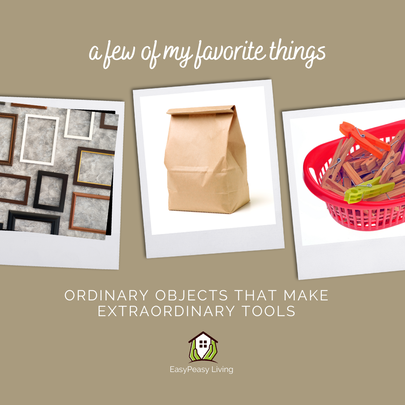 One of the most common questions I get is “What organizing tools should I buy to get started?” My answer is simple: “Nothing!” You don't have to spend a lot of money getting organized. While it may be tempting to purchase cute canisters for your pantry or boutique baskets for your closet, it is wiser to spend your decorating dollars on the spaces your guests will actually see than on organizing the stuff that's kept hidden behind closed doors. And contrary to popular belief, all those cute bins and cool gadgets from The Container Store don’t come with a lifetime supply of magic fairy dust that will automatically transform your home into an orderly oasis. Not to mention that going on a pre-organizing shopping spree, while a fun way to procrastinate on actually tackling your project, can end up becoming overwhelming and wind up adding to your problem of having too much stuff. The good news is that you are likely already surrounded by the best, most versatile tools on the market...you just don’t realize it! And all these items are easily adaptable if/when your needs change, unlike that task-specific gadget you paid too much for at your favorite home goods store. December is Top Tips Month here at EasyPeasy Living, and this week I'm sharing 16 of my favorite things...ordinary, everyday objects most people already have lying around the house that, with a little creativity, you can transform into extraordinary tools for staying organized or just making life a little easy peasier. Be sure to follow @EasyPeasyLiving on Facebook and Instagram, where I’ll be sharing my top five most favorite favorites in the coming week. I may not have a magic wand, but these little gems are the next best thing. First a word of caution: resist the temptation to hoard any of these. Most will be in pretty constant supply, so you can afford to wait until you have a specific need to begin collecting. OK, here we go! Bread Clips I recently saw a picture of a wedding gown made from 10,000 plastic bread bag clips. That may be a bit extreme, but there are lots of practical uses for these little plastic doohickies:
Candle Jars I love lighting candles to cozy up my home on long winter nights! From October through March, I enjoy snuggling up in front of their warm glow each evening. My favorites are the jar candles because they are less messy, keep their shape, and - best of all - the glass jars can be cleaned out and re-purposed to store all manner of things once the candle inside has burned itself out. Jar candles come in so many shapes and sizes, so the storage opportunities are endless. You can even fill them with something wonderful and gift them! Some of my favorite things to store in them:
Contact Lens Cases Do you get a new case every time you buy solution? Don’t throw the old one out! These miniature lidded containers yield super-sized space savings and convenience, especially when travelling. Tuck them into your purse, backpack, fanny pack, suitcase or camping gear. Here are just a few of the many things you can store in them:
“Disposable” Food Storage Containers (such as Take-Along or Ziploc containers): Closet and cabinet organizing is all about function and how to fit, find and access what you need as efficiently as possible. That's why I love these inexpensive containers for storing everything from pretzels to pencils. They come in varying sizes and are transparent, airtight, versatile, stackable and easily labeled. Best of all, you can pick up as many as you need for next to nothing and easily find them at most stores that sell housewares or groceries. Or just go "shopping" in your recycle bin. Divided Boxes Keeping small items organized can be a challenge. I love it when a gift or purchase comes packaged in a box with dividers, but you can also purchase plastic divided boxes at most craft stores or home goods stores that are stackable and easily transportable. Here are just a few ideas of things to store in them:
Life changes fast. Sometimes you need a low-tech communication device that travels well and can change right along with it. The dry erase marker isn't just for white boards, my friends!
Eyeglass Cases Both the open-ended, soft kind or the hard, hinged eyeglass cases make great storage receptacles for so many objects inside your drawers, purse, backpack or suitcase. Here are just a few things you can store inside them:
Hydrogen Peroxide One of the best ways to save space is to equip yourself with multi-taskers. Why buy and store a gazillion different toxic and expensive cleaners, stain removers, disinfectants, and whiteners when all you need is one bottle of this multi-purpose miracle? (Well okay, you should probably buy more than one bottle of it for all these uses.) Hydrogen peroxide has anti-bacterial, anti-viral, anti-mold, anti-fungal and anti-mildew properties and is non-toxic and environmentally-friendly. And while it may be worth its weight in gold, it has a price tag you'll love almost as much as its versatility. Use it to: Disinfect/Sterilize:
Lazy Susans Let's face it...we are all lazy about something. Embrace your laziness and make it work for you! These little turntables come in a variety of sizes. A few places they can help you spin into action instead of spinning your wheels include:
Mason Jars There's a reason our mothers and grandmothers kept a supply of these around! They’re economical, environmentally-friendly, reusable, versatile and inexpensive! Sold in most grocery or home goods stores by the dozen for about a buck per jar, they are a worthwhile investment. Or just befriend someone who likes to give homemade jam as gifts! Here are just some of the many ways you can use them around the house:
Paper Bags I always keep a stash of these on hand because they are so versatile. In addition to the obvious, use them for:
Picture Frames They say a picture paints a thousand words, but a picture frame can say a lot about how organized and creative you are! Try one of these ideas for putting yours to work for you:
Sandpaper Every well-stocked toolbox contains sandpaper, but you'll want to reserve a spot for it in other areas of your home when you see all its uses! Use it in your:
Shoe Pocket Organizers With this little organizing trick in your pocket, you'll create storage space you never knew you had. Those transparent plastic or mesh shoe holders you hang on the back of your closet door are nothing less than a pocketful of miracles when it comes to maximizing on your vertical storage space! Here are just a few ideas for what to store in them:
Spring-loaded Clothespins So simple and low-tech, it's easy to overlook the power in their pinch! Next time you are near a dollar store, pick up a pack of those spring-loaded wooden clothespins. They will perform all kinds of little jobs around the house to make your life a little easy peasier. A few examples:
Tension Rods Maximize your vertical space with tension rods! No hardware or tools required to install these wherever you need to create storage.
And all these ideas are just the tip of the iceberg! Go on Pinterest or Google or just use your own imagination to find additional uses for each of these things. If you find a new one or have a favorite thing of your own, share it with me before December 27 for a chance to win a copy of James Clear’s bestselling book, Atomic Habits. (To learn more about entering the 2020 Top Tips Contest, visit www.easypeasyliving.com/news.) With a few of my favorite things, getting organized without any fancy organizing tools will be easy peasy! on't miss out! Sign up to have each new EPL Blog post delivered to your inbox each week.
|
AuthorValerie Sheridan is a professional organizer, wife, mother of two, and Founder/Owner of EasyPeasy Living. Archives
October 2022
Categories
All
|

 RSS Feed
RSS Feed